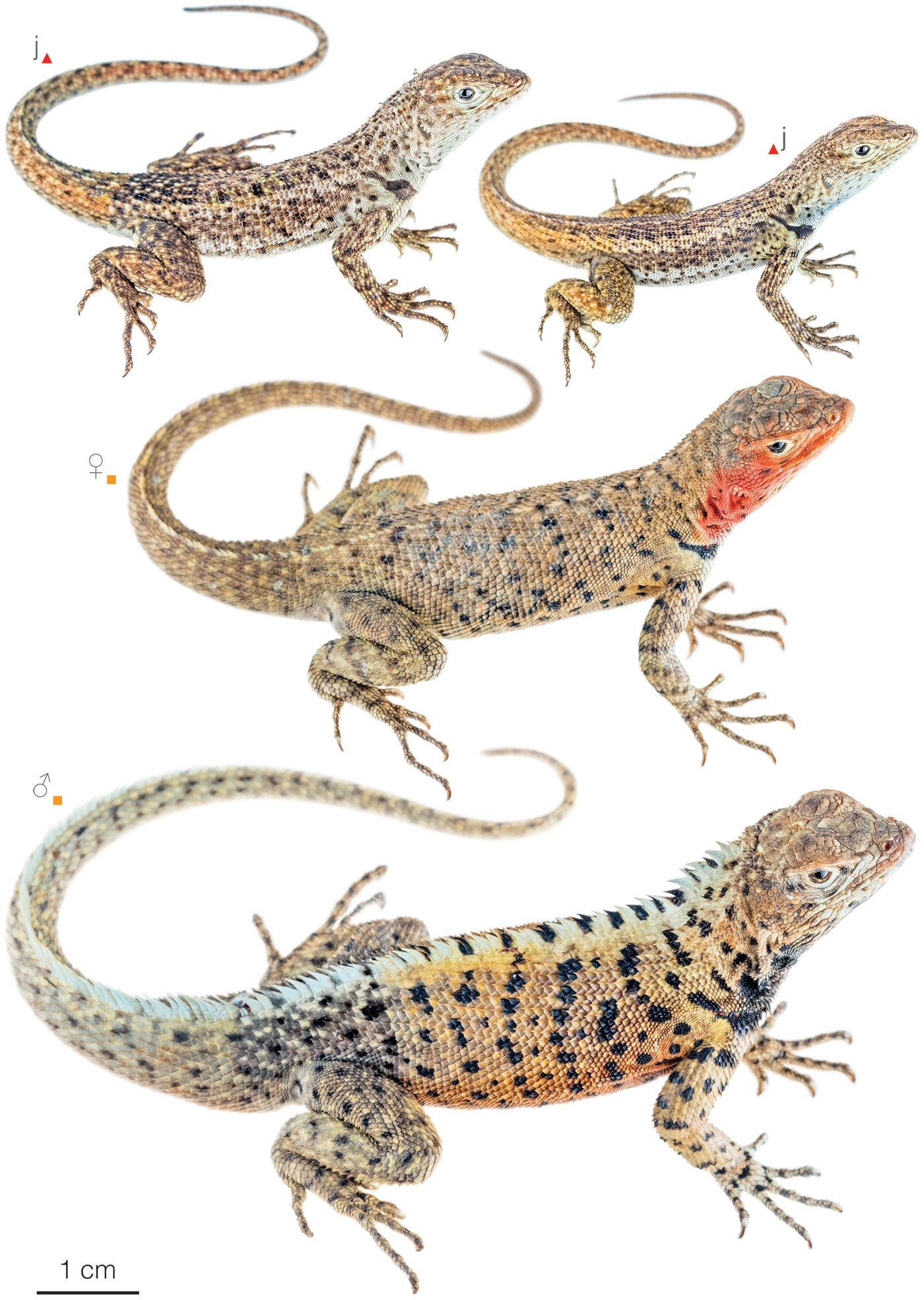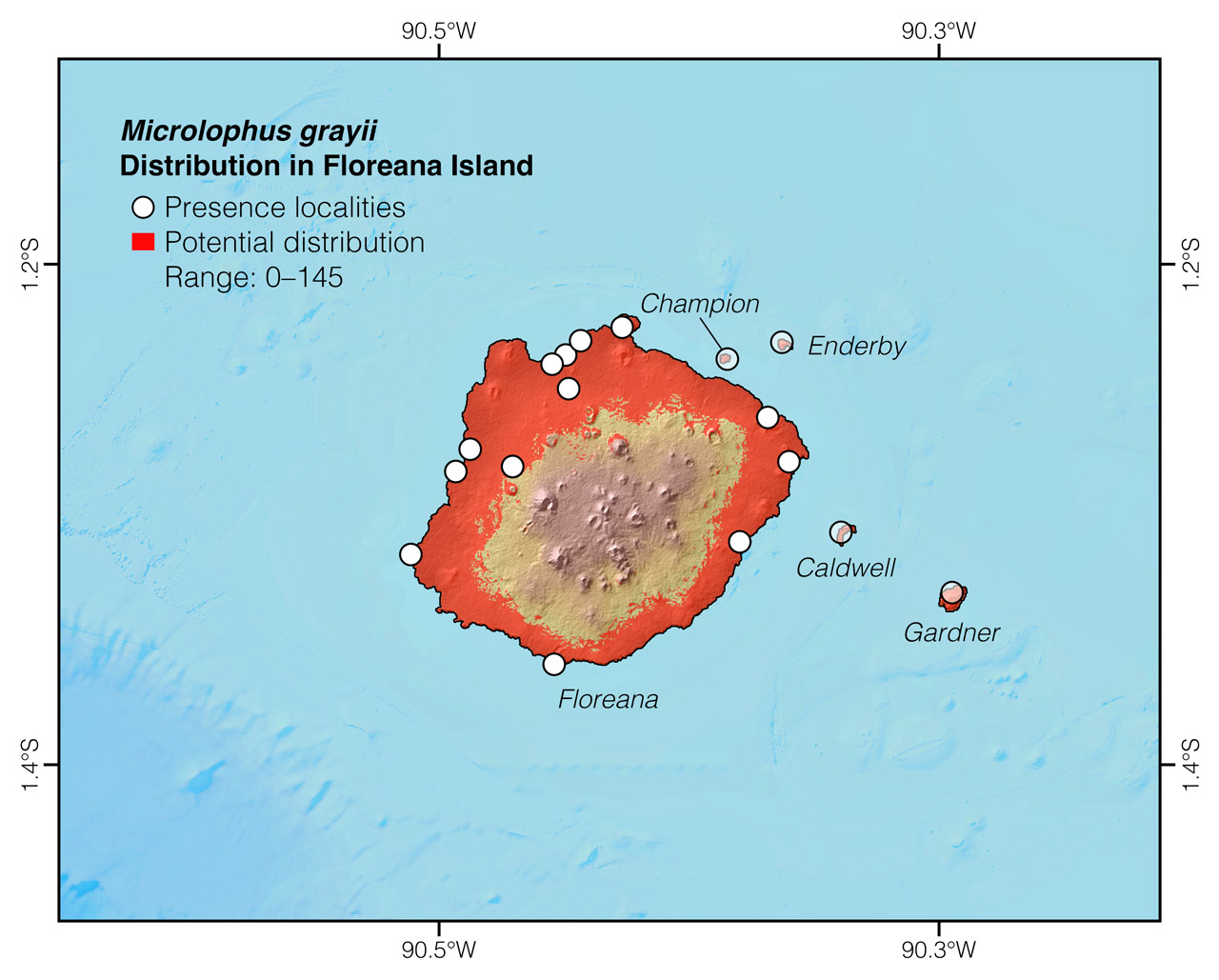Published October 10, 2019. Updated January 23, 2024. Open access. Peer-reviewed. | Purchase book ❯ |
Floreana Lava-Lizard (Microlophus grayii)
Reptiles of Ecuador | Sauria | Tropiduridae | Microlophus grayii
English common name: Floreana Lava-Lizard.
Spanish common name: Lagartija de lava de Floreana, lagartija de lava de Gray.
Recognition: ♂♂ 24.4 cmMaximum distance from the snout to the tip of the tail. Snout–vent length=6.9 cm. ♀♀ 21.9 cmMaximum distance from the snout to the tip of the tail. Snout–vent length=7.3 cm..1,2 Microlophus grayii is easily distinguishable from other native lizards occurring on Floreana Island (that is, iguanas and leaf-toed geckos) by having keeled scales on the tail, a skin fold above the shoulder, a raised mid-dorsal crest, and a conspicuously enlarged interparietal scale.1 Microlophus grayii is the only lava lizard occurring on Floreana Island. Adult males are easily recognized by their raised black-and-whitish middorsal crest and distinctive black throat.1 Adult females may be recognized by their bright orange face (Fig. 1).1

Figure 1: Individuals of Microlophus grayii from Galápagos, Ecuador: Puerto Velazco Ibarra, Floreana Island (); Gardner Islet (). j=juvenile.
Natural history: Microlophus grayii is a diurnal lizard that occurs in high densities in volcanic rock areas, dry shrublands, dry grasslands, deciduous forests, and urban areas of Floreana Island.1 During the early morning and late afternoon, Floreana Lava-Lizards may be seen basking and foraging on soil, rocks, and tree trunks up to 3.5 m above the ground.1 To avoid the hottest hours of the day, they move into the shade, sitting on surfaces that have not been heated by the sun. They spend the night hidden among rocks, beneath soil, and leaf-litter.1 The diet in M. grayii consists of insects and plant material such as fruits and seeds.1,3 There are recorded instances of predation on lizards of this species, including by snakes (Pseudalsophis biserialis) and by domestic cats.1,4 Males of M. grayii defend territories by performing pushup displays and fighting with other males.1 Females build nests in sandy substrate close to rocks or vegetation.5
Conservation: Near Threatened Not currently at risk of extinction, but requires some level of management to maintain healthy populations..6 Microlophus grayii is listed in this category because the species is confined to Floreana and its associated islets, covering an area no greater than 100 km2. Being a small island, Floreana is susceptible to invasive predators, particularly cats, which have been confirmed as predators of M. grayii.1 Nevertheless, the species has not been shown conclusively to have undergone population declines due to this threat.
Distribution: Microlophus grayii is endemic to an area of approximately 95 km2 on Floreana Island and four of its surrounding islets (Caldwell, Champion, Enderby, and Gardner) in Galápagos, Ecuador (Figs 2, 3).

Figure 2: Distribution of Microlophus grayii in Galápagos. See Appendix 1 for a complete list of the presence localities included in the map.

Figure 3: Distribution of Microlophus grayii in Floreana Island. See Appendix 1 for a complete list of the presence localities included in the map.
Etymology: The generic name Microlophus comes from the Greek words mikros (=small) and lophos (=crest).1 The specific epithet grayii honors British zoologist John Edward Gray (1800–1875),7 keeper of zoology at the British Museum in London from 1840 until 1874.
See it in the wild: Floreana Lava-Lizards can be seen year-round with almost complete certainty on the outskirts of Puerto Velazco Ibarra, especially along the trail leading from the town to La Lobería.
Special thanks to Paul Andrew Johnston for symbolically adopting the Floreana Lava-Lizard and helping bring the Reptiles of Ecuador book project to life.
Click here to adopt a species.
Authors: Alejandro Arteaga,aAffiliation: Fundación Khamai, Reserva Arlequín, Ecoruta Paseo del Quinde km 56, Santa Rosa de Mindo, Pichincha 171202, Ecuador. Gabriela Aguiar,bIndependent researcher, Quito, Ecuador. and Juan M GuayasamincAffiliation: Universidad San Francisco de Quito, Quito, Ecuador.
Academic reviewers: Edgar Benavides,dAffiliation: Yale University, New Have, USA. John Rowe,eAffiliation: Alma College, Alma, USA. and Cruz MárquezfAffiliation: University of Rome Tor Vergata, Rome, Italy.
Photographers: Jose VieiragAffiliation: Tropical Herping (TH), Quito, Ecuador.,hAffiliation: ExSitu, Quito, Ecuador. and Frank PichardogAffiliation: Tropical Herping (TH), Quito, Ecuador.
How to cite? Arteaga A, Aguiar G, Guayasamin JM (2024) Floreana Lava-Lizard (Microlophus grayii). In: Arteaga A, Bustamante L, Vieira J (Eds) Reptiles of Ecuador: Life in the middle of the world. Available from: www.reptilesofecuador.com. DOI: 10.47051/ATGH7471
Literature cited:
- Arteaga A, Bustamante L, Vieira J, Tapia W, Guayasamin JM (2019) Reptiles of the Galápagos: life on the Enchanted Islands. Tropical Herping, Quito, 208 pp. DOI: 10.47051/AQJU7348
- Bowman RI (1966) Proceedings of the Symposia of the Galápagos International Scientific Project. University of California Press, Berkeley, 336 pp.
- Hervías-Parejo S, Heleno R, Rumeu B, Guzmán B, Vargas P, Olesen JM, Traveset A, Vera C, Benavides E, Nogales M (2018) Small size does not restrain frugivory and seed dispersal across the evolutionary radiation of Galápagos lava lizards. Current Zoology 65: 353–361. DOI: 10.1093/cz/zoy066
- Christian EJ (2017) Demography and conservation of the Floreana racer (Pseudalsophis biserialis biserialis) on Gardner-by-Floreana and Champion islets, Galápagos Islands, Ecuador. PhD thesis, Auckland, Massey University, 186 pp.
- Burger J (1993) Colony and nest site selection in lava lizards Tropidurus ssp. in the Galápagos Islands. Copeia 1993: 748–754.
- Márquez C, Cisneros-Heredia DF (2016) Microlophus grayii. The IUCN Red List of threatened species. Available from: www.iucnredlist.org. DOI: 10.2305/IUCN.UK.2016-1.RLTS.T48444750A48444762.en
- Uetz P, Freed P, Hošek J (2016) The Reptile Database. Available from: www.reptile-database.org
Appendix 1: Locality data used to create the distribution map of Microlophus grayii in Ecuador (Fig. 2). Go to the section on symbols and abbreviations for a list of acronyms used.
| Country | Province | Locality | Source |
| Ecuador | Galápagos | Bahía de las Cuevas | iNaturalist; photo examined |
| Ecuador | Galápagos | Bahía La Baronesa | Benavides et al. 2009 |
| Ecuador | Galápagos | Caldwell islet | Benavides et al. 2009 |
| Ecuador | Galápagos | Champion islet | Arteaga et al. 2019 |
| Ecuador | Galápagos | Enderby islet | Van Denburgh and Slevin 1913 |
| Ecuador | Galápagos | Gardner islet | Van Denburgh and Slevin 1913 |
| Ecuador | Galápagos | La Lobería | Arteaga et al. 2019 |
| Ecuador | Galápagos | Las Cuevas | Benavides et al. 2009 |
| Ecuador | Galápagos | Post Office bay | Arteaga et al. 2019 |
| Ecuador | Galápagos | Post Office bay, 2 km S of | iNaturalist; photo examined |
| Ecuador | Galápagos | Puerto Flores | iNaturalist; photo examined |
| Ecuador | Galápagos | Puerto Velazco Ibarra | Arteaga et al. 2019 |
| Ecuador | Galápagos | Puerto Velazco Ibarra, 2 km SE of | Arteaga et al. 2019 |
| Ecuador | Galápagos | Punta Ayora | Benavides, 2007 |
| Ecuador | Galápagos | Punta Cormorán | Van Denburgh and Slevin 1913 |
| Ecuador | Galápagos | Punta Ensillada | iNaturalist; photo examined |
| Ecuador | Galápagos | Punta Sur | Arteaga et al. 2019 |
| Ecuador | Galápagos | Unnamed road 1 | iNaturalist; photo examined |